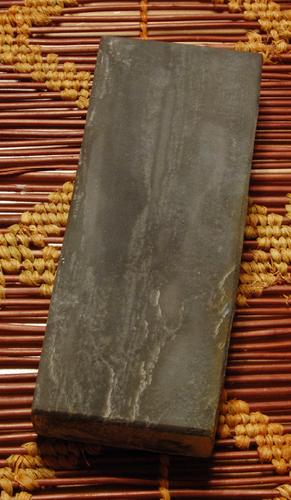Results 11 to 20 of 28
Thread: Turkey Stone Research
-
11-20-2017, 11:14 PM #11

I notice that the photo you have attached appears to come from the Razor Loves Stones site. I would suggest contacting Sebastian there, if you haven't done so already, as he has a lot of esoteric information as to the history of stone usage and so forth. Like the others have said, it comes from Crete, which was part of the Ottoman empire at the time. Another thing to bear in mind is how the stone might have been used. In the eastern Mediterranean, my understanding is that the traditional method is to charge the stone with milk-fat through a slow boiling process to fill in the imperfections. This also aids in darkening it and increases its translucency. After charging, the stone is used with olive oil. That being the case, I have my doubts that olive oil would have been used in 18th-century Pennsylvania. And the whaling industry didn't really kick in until the 19th century. So what would have been the honing medium used then? Perhaps your historical literature will provide a clue. I'd be curious to know.
Last edited by Brontosaurus; 11-20-2017 at 11:16 PM.
Striving to be brief, I become obscure. --Horace
-
11-21-2017, 02:08 AM #12Junior Member

- Join Date
- Nov 2017
- Posts
- 8
Thanked: 0
They did have access to olive oil at the time, though they referred to it as sweet oil usually. This could, though, also refer to just about any vegetable oil from the period. Unfortunately, we don't have a lot of good descriptions of what they used for a sharpening oil, as that was generally considered a trade secret. Thanks for the tip to ask Sebastian though, I'll do just that!
-
11-21-2017, 02:37 AM #13
-
11-21-2017, 02:49 AM #14Junior Member

- Join Date
- Nov 2017
- Posts
- 8
Thanked: 0
That's the modern convention, but in the 18th century there tended to be less standardization of terms. One favorite example we ran into recently with a recipe was: add as much flour as necessary to make a cake. They weren't always very specific in their descriptions.
-
11-21-2017, 08:28 AM #15Truth is weirder than any fiction..


- Join Date
- Jun 2012
- Location
- Land of the long white cloud
- Posts
- 2,946
Thanked: 580
Given the location and time period, olive oil was certainly the most predominant lubrication. Would have been the tail end of the extraction process, most of it being for consumption. I have one, but only got as far as lapping it flat. Might have to treat it with some extra virgin..
Into this house we're born, into this world we're thrown ~ Jim Morrison
-
11-21-2017, 10:51 AM #16

Olive oil in 18th century Pennsylvania? As an alternative, I would have thought some sort of animal fat or grease. Weren't some of the first petroleum oil fields located in Pennsylvania? But that comes much later...
Striving to be brief, I become obscure. --Horace
-
11-21-2017, 11:07 AM #17Junior Member

- Join Date
- Nov 2017
- Posts
- 8
Thanked: 0
It was certainly available, but expensive. Most cooking would use animal fats, but those don't stay liquid at room temperature usually, so not as good for lubrication.
-
11-21-2017, 04:40 PM #18

From old literature that I have read, and what others here have said, the Washita came along in the 1800ís and was so much more consistent leaving a better edge that they pushed the turkey stone out of the market which was also know for cracks and inclusions. From what I remember reading from a geological survey in the late 1800ís the Washitas were actually more expensive (at that time) and everyone seemed to sell them but with all of these other natural stones in the America like the Labrador and fine sandstones they were replaced quickly by the Washita, Hard Arkansas, and India Oil Stones. So many were gone by the turn of the 20th century. Now maybe a turkey stone of another name is available, that I donít know.
What a curse be a dull razor; what a prideful comfort a sharp one
-
11-21-2017, 04:48 PM #19

“The Turkey stone.—The Turkey stone is so well known, and has so long been the standard of excellence for whetstones, that these descriptions would not be complete without it. Hitherto....The veins of calcite injure the stone for sharpening fine-pointed instruments, since they mar the evenness of texture desirable, and render it liable to uneven wear. Altogether it does not seem that the Turkey stone would do such fine work as the Arkansas and Ouachita stones. It is much cheaper than the Arkansas stone, but not so “cheap as the Ouachita. Sometimes, however, Turkey stones are found without the calcite veins; these must be excellent stones, though not.so fine as the Arkansas nor so fast cutting as the Ouachita.”
Excerpt From
Annual Report of the Geological Survey of Arkansas ...
Geological Survey of Arkansas
This material may be protected by copyright.What a curse be a dull razor; what a prideful comfort a sharp one
-
11-21-2017, 05:26 PM #20

FWIW, here are two pictures of a Turkey stone I acquired from a Turkish dealer, before and after the boiled milk treatment I mentioned above. Really a nice stone, with a feel and result similar to a translucent Arkansas. I've only used it with olive oil.

 Striving to be brief, I become obscure. --Horace
Striving to be brief, I become obscure. --Horace


 14Likes
14Likes LinkBack URL
LinkBack URL About LinkBacks
About LinkBacks






 Reply With Quote
Reply With Quote


